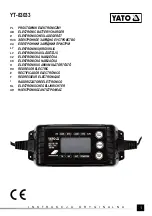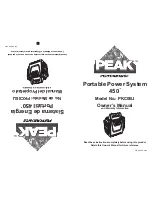
CAUTION! Do not use the modified inverter with the following
equipment:
Certain chargers for small nickel-cadmium batteries can be damaged if plugged into a modified sine
wave inverter. In particular, two types of appliances are susceptible to modified sine wave: •
• Small, battery-operated appliances such as flashlights, cordless razors and toothbrushes that can be
plugged directly into an AC receptacle to recharge.
• Certain battery chargers for battery packs that are used in some cordless hand-tools. Chargers for these
tools have a warning label stating that dangerous voltages are present at the battery terminals.
• Sensitive electrical or electronic items such as certain medical equipment
The majority of portable appliances do not have this problem. Most portable appliances use separate
transformers or chargers that plug into AC receptacles to supply a low-voltage DC or AC output to the
appliance. If the appliance label states that the charger or adaptor produces a low-voltage DC or AC
output (30V or less), there should be no problem powering that charger or adaptor.
Safety Warning: 240V of electricity can be lethal. Improper use of a power inverter will result in
property damage, personal injury, or loss of life. Please read and follow carefully the instructions in he
instruction manual provided with every inverter for important safety considerations and recautions.
General Safety Precautions and Installation Tips:
• Place the inverter on a reasonably flat surface, either horizontally or vertically.
• The inverter should not be installed in the engine compartment, due to possible water/oil/acid
contamination, and excessive heat under the bonnet, as well as potential danger from petrol fumes
and the spark that an inverter can occasionally produce. It’s best to run battery cables to a dry, cool
mounting location.
• Keep the inverter dry. Do not expose it to rain or moisture. DO NOT operate the inverter if the
inverter, the device being operated, or any other surfaces that may come in contact with any power
source are wet. Water and many other liquids can conduct electricity which may lead to serious injury
or death.
• Do not opeate the inverter in dusty enviroments. Keep the fan clean.
• Avoid placing the inverter on or near heating vents, radiators or other sources of heat. Do not place the
inverter in direct sunlight. Ideal operating temperature is between 10° and 30°C.
Allow at least 2 inches ( 5cm ) of air space on all sides of the inverter. During operation, keep away from
materials that may be affected by high temperatures.
• In order to properly disperse heat generated while the inverter is in operation, keep it well ventilated.
While in use, maintain several inches of clearance around the top and sides of the inverter.
• DO NOT use the inverter near flammable materials.
• DO NOT install inverters in unvented battery compartments.
• DO NOT expose the inverter to temperatures exceeding 40C
• DO NOT connect live AC power to the inverter’s AC outlets. The inverter will be damaged even if it is
switched OFF.
CAUTION! Any internal adjustment on the inverter is prohibitited. Do not disamemble.
Page 11






































